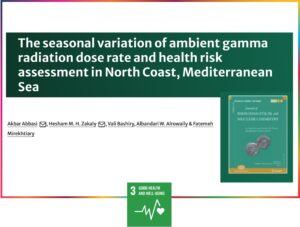
This research delves into the examination of seasonal fluctuations in ambient gamma radiation dose rates and associated outdoor gamma radiation risk in the northeast region of Cyprus. Employing an Ion Chamber Survey Meter, the study measured ambient gamma radiation at a height of 100 cm above ground level. Results indicated average ambient gamma dose rates of 135 nGyh−1, 185 nGyh−1, 187 nGyh−1, and 191 nGyh−1 during winter, autumn, spring, and summer, respectively. Notably, excess lifetime cancer risk (ELCR) values at the tested sites surpassed the global average.
Conducted across sixteen locations in the study area, the research utilized portable gamma dosimeter tools to assess seasonal variations in ambient gamma radiation dose rates. The analysis also explored correlations between ambient gamma dose rates and environmental parameters. While outliers were observed, overall findings revealed elevated ambient gamma radiation dose rates in summer and lower rates in winter. Crucially, the average ambient gamma dose rate across all locations exceeded the global average. Despite low-level radiation exposure in the environment lacking immediate health effects, it contributes to the overall risk of cancer development. The study highlighted a noteworthy observation: the total cancer risk in the study area exceeded the global average, suggesting a link between increased gamma radiation and heightened overall cancer risk.
Considering the potential influence of other variables on total cancer risk, the research advocates for further comprehensive investigations in this area. The findings underscore the importance of monitoring and understanding seasonal variations in ambient gamma radiation, emphasizing the need for ongoing research to delineate potential health implications and inform public health strategies.
More Information:
https://link.springer.com/article/10.1007/s10967-023-09132-8